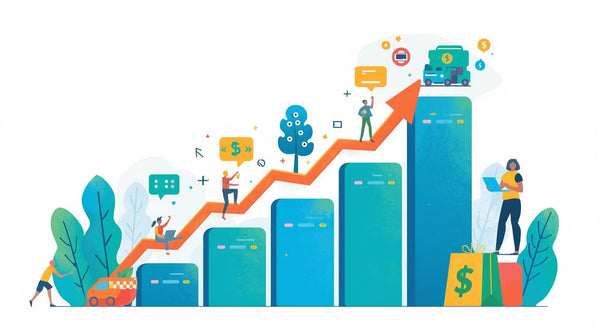Payment in Shopify: What Every Store Owner Needs to Know
1. Why Payment Matters More Than You Think
In e-commerce, payment isn’t just the technical moment when money moves from a customer’s card to your bank account. It’s the final trust test. Up until that point, your visitor is only window-shopping. They may have clicked on ads, browsed your collections, read reviews, even added items to the cart but until they actually complete a payment, nothing is real.
This is why the checkout and payment stage is often called the “moment of truth.”
Here’s why it matters so much:
-
Trust is fragile. Customers will forgive a slow-loading product page or a slightly clunky menu, but they won’t forgive a payment system that feels insecure. If your checkout looks outdated, lacks common payment options, or throws unexpected errors, buyers will instantly back out.
-
Cart abandonment happens fast. According to studies, over 65% of carts are abandoned before payment. The reasons are often simple hidden fees, no preferred payment method, or too many form fields. Each friction point at checkout is like a brick wall stopping the customer.
-
Your investment is on the line. Think of the effort you’ve already put in: ads, SEO, product descriptions, photography, social media marketing. All of it drives people toward one goal payment. If the final step fails, every dollar you spent to bring that customer in goes to waste.
A smooth payment process, on the other hand, does more than process money it creates confidence. It tells customers, “This store is legitimate. Your information is safe. You’ll get your order.” That reassurance is what turns first-time buyers into loyal repeat customers.
In short: payment is not the end of the customer journey; it’s the point where your business actually begins.

2. The Role of Payment in Shopify Stores
When we talk about Shopify stores, design, apps, and product strategy often get most of the attention. But the truth is, your payment setup is just as critical as your home page or your product pages. Why? Because it doesn’t just “process money.” It defines the shopping experience, influences customer trust, and determines how smoothly your business runs behind the scenes.
Here’s how payment plays a central role in Shopify success:
-
It signals trust and legitimacy. A customer might love your product, but if they don’t recognize or trust the payment gateway, you’re using, they’re likely to back out. Seeing familiar names like Shopify Payments, PayPal, Stripe, Apple Pay, or even local options like Klarna or After pay signals credibility instantly.
-
It connects global customers to your products. Shopify is built for international reach. Offering multiple currencies and region-specific payment options means you’re not shutting out buyers from Europe, Asia, or anywhere else. Without this, your store looks local even if your product has global appeal.
-
It directly impacts your cash flow. Payment providers don’t just collect money; they dictate how quickly you receive it, and at what cost. Transaction fees, payout schedules, and hidden charges all affect your bottom line. A poorly optimized setup could mean lost profit every single sale.
-
It influences repeat purchases. Customers love convenience. If their first checkout experience is fast, secure, and hassle-free, they’ll come back. On Shopify, features like Shop Pay save customer details for one-click repeat buying, which can massively boost customer lifetime value.
-
It sets the tone for your brand. Payment isn’t just functional it’s emotional. A polished, modern, seamless checkout feels aligned with a premium brand. A clunky, outdated, or confusing process makes even the best products feel second-rate.
Think of it this way: a poorly handled payment flow is like having a stunning boutique store with a broken cash register. Customers may admire your products, but they’ll walk out without buying. On the flip side, a smooth payment experience is like having a checkout line that’s fast, secure, and welcoming something that keeps customers coming back.

3. Elements Every Shopify Payment System Needs
A payment process isn’t just about letting someone swipe a card or click a button it’s about removing friction, building trust, and creating a smooth handoff between “I want this product” and “I’ve bought it.” In Shopify, this is where you win or lose the sale. To get it right, every payment setup needs a few essential elements:
-
Multiple Options
Today’s shoppers are picky. Some stick to credit cards, others prefer PayPal, and a growing number lean on digital wallets like Apple Pay or Google Pay. Add Buy Now, Pay Later (BNPL) solutions like Klarna or Afterpay, and you’re giving customers flexibility. If a store only offers one or two methods, it unintentionally tells some shoppers, “We’re not for you.” In Shopify, enabling multiple gateways is simple and it pays off in higher conversions. -
Security
At checkout, customers are literally handing over their most sensitive details. That’s why SSL encryption, PCI compliance, and fraud detection are non-negotiable. Shopify handles much of this for you through Shopify Payments, but if you’re using third-party gateways, ensuring strong fraud filters is critical. A single breach can permanently damage trust and brand reputation. -
Mobile-Friendliness
With more than 70% of e-commerce purchases happening on mobile devices, your payment flow has to be designed for thumbs, not keyboards. That means responsive checkout pages, one-click payment options, and minimal form fields. Shopify’s Shop Pay is a prime example it stores customer info for lightning-fast repeat purchases. -
Speed
Every extra second in checkout increases the risk of abandonment. Customers don’t want to type endless fields or wait for laggy pages to load. A fast, optimized checkout keeps momentum high. Shopify’s built-in checkout is designed for speed, but cluttering it with too many upsells or extra steps can slow things down. -
Transparency
Nothing kills a sale faster than hidden fees or last-minute surprises. Customers want to see the full breakdown product cost, shipping, taxes, and any extra charges before hitting pay. Transparency avoids frustration and reduces abandoned carts. Shopify makes it possible to customize how this information is displayed, so use it to build clarity.
Each of these isn’t just a “nice to have” they’re the difference between winning a customer or losing them at the final step. A missing payment option, a slow mobile checkout, or an unclear total can undo all the work you’ve put into your ads, design, and product descriptions.
Think of your Shopify payment system as the bridge between interest and revenue. If the bridge has cracks limited options, slow speed, hidden fees customers won’t cross it. But if it’s strong, secure, and simple, people will happily walk across again and again.

4. SEO and Payment Pages: What’s the Connection?
At first glance, payment pages don’t look like an SEO battleground. After all, most of them are locked behind checkout and don’t get indexed in the same way product or collection pages do. But here’s the catch: payment pages directly influence the user experience signals that search engines like Google measure. And in e-commerce, user experience is half the SEO game.
Here’s how payment pages connect to SEO performance:
-
Trust Signals Improve Rankings
Google’s algorithm rewards sites that look safe, secure, and user-friendly. A well-structured checkout that highlights SSL badges, trust seals, and secure payment gateways reassures both buyers and search engines. A “secure site” isn’t just branding—it’s a technical ranking factor. -
User Behavior Impacts SEO
If customers reach checkout and immediately leave because the payment process feels clunky, confusing, or untrustworthy, that sends negative signals. High bounce rates and low completion rates indirectly hurt SEO because Google interprets it as a bad user experience. On the flip side, smooth checkout flows mean customers stay, convert, and return which strengthens behavioral metrics. -
Internal Linking Strengthens Context
Most store owners overlook this. Checkout pages are a great place to subtly link back to FAQs, return/refund policies, shipping info, or customer support pages. These internal links boost site structure, reinforce authority, and keep customers informed. Even though the checkout itself may not rank, the linked pages do and they benefit from improved crawlability. -
Page Speed Matters Everywhere
Google has made it clear: Core Web Vitals and speed performance are ranking factors. If your checkout page is bloated with scripts, slow-loading buttons, or heavy design elements, it not only kills conversions but also contributes to poor site performance overall. Shopify’s optimized checkout helps, but customizing too heavily without speed checks can backfire. -
Mobile-Friendly Checkout Supports SEO
With most users coming from mobile search, a mobile-first checkout is an SEO asset. If customers drop off because your payment page is hard to use on a phone, Google sees that as weak mobile UX something that hurts rankings across the site.
So while your Shopify payment page might not be the first thing to rank on Google, it protects and reinforces your SEO ecosystem. A checkout that performs poorly drags down site trust, conversions, and behavioral signals exactly the things search engines weigh heavily.
Think of it this way: SEO drives traffic to your store, but your payment process decides whether that traffic converts. If your checkout is slow, unclear, or untrustworthy, you’re not just losing sales you’re telling Google that your site doesn’t deliver on its promise.

5. Advantages of a Seamless Payment System
A seamless payment flow is more than just a convenience it’s a profit engine. Most Shopify store owners think of payment processing as a back-end necessity, but in reality, it’s a front-line driver of sales, trust, and growth.
Here’s why a smooth payment setup matters so much:
-
Higher Conversion Rates
When the payment process is simple fewer clicks, clear instructions, and no unnecessary forms customers are far more likely to complete their purchase. Shopify’s one-page checkout is designed to remove friction, and the result is fewer abandoned carts and more finished orders. -
Lower Cart Abandonment
Complicated checkouts are the #1 cause of cart abandonment in e-commerce. Adding guest checkout options, digital wallets like Apple Pay or Google Pay, and Buy Now Pay Later (BNPL) reduces hesitation. Customers love speed and flexibility, and the right payment setup delivers both. -
Stronger Customer Trust
Security logos, SSL badges, and familiar payment gateways give customers peace of mind. A trusted payment environment makes buyers feel safe sharing their details and that trust leads to repeat purchases and stronger brand loyalty. -
Global Reach with Multi-Currency Options
If you’re aiming to sell beyond your local market, your payment system must support multi-currency and localized gateways. A Canadian store accepting USD, GBP, or EUR payments instantly becomes more accessible to international buyers, removing barriers to entry. -
Scalability for Growth
As your Shopify store grows, so will transaction volume. A well-optimized payment system can scale effortlessly handling seasonal surges, promotional campaigns, or even viral product launches without causing downtime or errors at checkout. -
Reduced Operational Headaches
The right payment integration helps with automatic tax calculations, fraud detection, and streamlined refunds. This means less manual work for store owners and more time spent on sales and marketing instead of chasing payment issues. -
Improved Customer Lifetime Value (CLV)
When customers know your store is quick, secure, and hassle-free to pay on, they’re more likely to return. Smooth payments don’t just win the first order they make repeat business more natural.
Insight:
A seamless payment system is not just an expense on your balance sheet. It directly generates revenue by improving conversions, boosting trust, and expanding your market reach. In e-commerce, payments aren’t the end of the journey they’re the bridge to long-term growth.

6. Disadvantages of Poor Payment Setup
On the flip side, a poorly managed payment system doesn’t just hurt conversions it quietly drains profit from your Shopify store. Many store owners invest in ads, design, and inventory but overlook checkout, not realizing it’s often the biggest leak in the bucket.
Here’s how a weak payment setup impacts your business:
-
High Cart Abandonment
Studies show that 60–70% of online carts never make it past checkout. Clunky payment flows, mandatory account creation, or limited options push customers to quit. Every abandoned cart is not just a missed sale it’s wasted ad spend and lost acquisition cost. -
Security Risks and Fraud Exposure
Without proper fraud detection, PCI compliance, or SSL encryption, your store becomes a target for scammers. One breach can permanently damage your reputation and cost thousands in chargebacks or penalties. Shopify offers built-in fraud analysis, but if your payment setup isn’t optimized, you could still be at risk. -
Limited Reach Due to Few Options
If you only accept credit cards, you’re excluding entire buyer groups. Shoppers today expect PayPal, Apple Pay, Google Pay, Shop Pay, BNPL, and even local gateways depending on their region. Without them, you’re losing out on both international and domestic customers. -
Customer Frustration and Lost Loyalty
Imagine a customer ready to buy but hitting a wall whether it’s errors, missing wallet support, or confusing form fields. Frustration during checkout doesn’t just kill the sale; it damages the relationship. Most buyers won’t come back if their first purchase attempt fails. -
Higher Operational Costs from Chargebacks
Outdated or poorly configured payment systems often result in chargebacks and disputes. These not only cost you money in fees but also hurt your merchant reputation, making future transactions riskier and more expensive to process. -
Slow Cash Flow
Delayed payouts, restricted gateways, or excessive transaction fees eat into profits and slow down reinvestment opportunities. For a growing Shopify business, inconsistent cash flow can choke marketing budgets and inventory restocks. -
Hidden Impact on SEO and Ads
Poor payment performance leads to higher bounce rates and abandoned checkouts, which indirectly affect your site’s SEO signals. On top of that, ad spend becomes less efficient when checkout conversions lag behind traffic growth.
Insight:
Payment problems are silent profit killers. Store owners often blame products, ads, or pricing, when in reality the checkout process is the leak. Fixing it doesn’t just stop losses it can unlock immediate growth without increasing marketing spend.

7. Common Mistakes Shopify Owners Make With Payments
Even with Shopify’s strong checkout infrastructure, store owners often overlook the finer details that make-or-break conversions. Payment is not just a “backend function” it’s part of your customer experience and trust-building process.
Here are the mistakes we see most often:
-
Only Offering Credit Card Payments
Relying solely on credit cards excludes a large chunk of buyers. Many shoppers prefer PayPal, Apple Pay, Google Pay, Shop Pay, or Buy Now Pay Later (BNPL) options. Without these, you’re limiting your reach and missing sales from younger audiences and international shoppers who prefer digital wallets. -
Not Testing Checkout Speed on Mobile
Mobile now drives the majority of Shopify purchases. If your checkout page loads slowly or form fields are hard to fill out on a phone, buyers will abandon instantly. A one-second delay can lead to measurable drop-offs. Yet, many store owners only test desktop flows. -
Forgetting to Display Trust Badges or SSL Certificates
Security is invisible until it’s missing. Customers look for SSL padlocks, payment trust badges, and fraud protection signals before entering card details. Without them, even an interested buyer may hesitate, doubting if the store is legitimate. -
Surprising Customers With Hidden Fees
Extra charges shipping costs, handling fees, or taxes that appear only at the last step create instant friction. Transparency builds trust. Shopify allows clear display of taxes and shipping earlier in the process, but too many stores skip this, leading to abandoned carts. -
Ignoring Local Payment Preferences
Selling globally but offering only U.S. credit card gateways is a common mistake. For example, iDEAL in the Netherlands, Klarna in Europe, or local wallets in Asia are must-haves for international trust. Shopify Payments and third-party integrations make this possible, but store owners often don’t configure them. -
Not Customizing the Payment Experience
Many Shopify stores leave checkout pages plain or generic, forgetting that small touches like clear CTAs, auto-fill fields, and minimal steps—boost trust and ease. Checkout should be as polished as your homepage. -
Failing to Regularly Test Payment Flows
Payment pages can break after app installs, theme changes, or gateway updates. If you’re not regularly test-driving your own checkout, you may not notice issues until sales dip.
Insight:
Your payment page should be as thoughtfully designed and optimized as your homepage or product page. Yet many Shopify owners neglect it, assuming Shopify’s default setup is “enough.” In reality, small mistakes at checkout can erase all the effort put into ads, design, and SEO.

8. How to Optimize Shopify Payment for Conversions
Optimizing payments isn’t about adding bells and whistles it’s about removing friction and creating an effortless checkout experience. Your customer has already decided to buy. The goal now is to make sure nothing gets in their way.
Here’s a detailed checklist to get it right:
-
Offer at Least 3–4 Popular Payment Options
Every shopper has a preferred method. Some trust credit cards, others rely on PayPal, and younger audiences love BNPL (Buy Now, Pay Later). Shopify makes it easy to integrate multiple gateways, so limiting yourself to one option means leaving money on the table. -
Use Shopify Payments for Lower Fees and Seamless Integration
Shopify Payments reduces reliance on third-party gateways, which often come with extra transaction fees and slower payouts. With Shopify Payments, you get native integration, instant setup, and lower costs—while still being able to offer wallets and local methods. -
Enable Express Checkout Buttons (Shop Pay, Apple Pay, Google Pay)
Speed matters. Shoppers who use express checkouts convert at a much higher rate because their details are saved and auto filled. Shop Pay, for example, is proven to increase conversions by up to 20%. It turns checkout from a 2-minute process into a 2-click action. -
Keep the Design Clean, With Fewer Form Fields
Every extra field creates friction. Do customers really need to type their full address twice? Simplify the process by enabling auto-fill, address validation, and a single-page checkout. Shopify’s new one-page checkout is a game-changer for this reason. -
Be Transparent About Costs Upfront
Shoppers abandon carts when they’re hit with unexpected shipping, taxes, or fees at the last step. Be clear about all costs early in the process. Shopify allows you to configure tax and shipping calculations before checkout begins—use it to avoid sticker shock. -
Test the Payment Flow Regularly on Different Devices
Payment systems can break after app installations, theme updates, or third-party changes. Don’t assume it’s always working. Run test orders on desktop, mobile, and tablets to ensure speed, layout, and functionality stay flawless. -
Think Global, Act Local
If you sell internationally, optimize for local currencies and payment methods. Shopify supports multi-currency checkouts and regional gateways use them to remove friction for buyers outside your home country.
Insight:
Optimization isn’t a one-time job. Customer habits evolve, new wallets and BNPL providers emerge, and fraud-prevention technologies improve. The stores that win are the ones that treat checkout as a living system, not a set-it-and-forget-it task.

9. Signs It’s Time to Upgrade Your Payment System
Most store owners don’t realize payment is the bottleneck until revenue takes a hit. A weak or outdated setup quietly eats into profits while you’re busy tweaking ads, products, or SEO. The truth? If checkout is broken, everything else loses power. Here are the red flags that signal it’s time for an upgrade:
-
Abandonment Rates Spike at Checkout
If analytics show plenty of “Add to Cart” activity but a steep drop-off during checkout, it’s not your products it’s your payment flow. Long forms, missing options, or slow loading pages push customers away right at the finish line. -
Customers Email Asking About Unavailable Payment Options
If buyers are reaching out to ask, “Do you accept PayPal?” or “Can I pay with Apple Pay?” it means your store isn’t meeting modern expectations. Shoppers shouldn’t have to ask; options should be there, ready, and visible. -
You Lose International Sales Due to Currency Issues
Selling globally requires more than shipping internationally. If your checkout doesn’t show localized currencies and regional payment methods, buyers hesitate. For instance, offering iDEAL in the Netherlands or Klarna in Europe can significantly boost conversions. Shopify Payments makes this seamless, but many stores overlook it. -
Chargebacks and Fraud Disputes Rise
A rise in disputes isn’t just costly it’s a trust signal gone wrong. It often points to weak fraud protection, poor communication, or lack of verification tools. Upgrading to systems with built-in fraud analysis (like Shopify Payments) minimizes these risks. -
Competitors Offer Smoother Checkout Experiences
If your rival’s checkout is faster, more flexible, or offers one-click payment while yours doesn’t, you’re handing them sales. Remember, in e-commerce, the store with the easiest checkout wins, even if their prices are higher.
Bottom line: When these signs appear, they’re not just inconveniences they’re early warnings of lost profit. Upgrading your payment system isn’t just about technology; it’s about protecting your brand’s reputation, maximizing conversions, and keeping pace with customer expectations.

10. Final Thoughts + Free Consultation Offer
Payment is where your Shopify store either seals the deal or loses the sale. It’s not just about processing money it’s about customer trust, SEO signals, and long-term revenue growth.
If you feel your payment setup could be improved whether that’s adding more options, reducing abandonment, or upgrading to Shopify Payments our team at EcomSpiders can help. We specialize in building complete Shopify solutions, and we’re happy to offer a free consultation to discuss how to optimize your store’s payment process for better sales and SEO.





0 comments